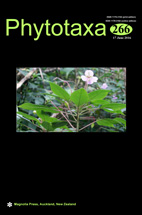Abstract
Gastrodia Brown (1810: 330) is a holomycotrophic terrestrial orchid genus of c. 65 species with an Old World distribution and centre of diversity in Southeast Asia (Cribb et al. 2010, Huang et al. 2015, Ong 2015). In the Philippines, two species are thus far known: G. javanica (Blume, 1825: 421) Lindley (1840: 384) and G. verrucosa Blume (1856: 175). Both have a widespread distribution in northern Malesia and southern East Asia. During fieldwork for the Co’s Digital Flora of the Philippine project (Pelser et al. 2011 onwards) in early December 2012, Gastrodia plants were photographed that belong to a third Philippine species. These plants were observed in three areas on the island of Mindanao: Mt. Apo Natural Park (North Cotabato Prov.) and two sites in Mt. Kitanglad Range Natural Park (Lantapan and Baungon municipalities; Bukidnon Prov.). In December 2015, plants belonging to the same species were collected in Northern Negros Natural Park (Victorias City, Negros Occidental Prov., Negros) and in March 2016 plants were photographed in Barlig (Mountain Prov., Luzon). Morphological studies showed that this species is distinct from all Gastrodia species except G. spathulata (Carr, 1935: 180) Wood (in Wood et al. 2011: 355) in having petals that are considerably shorter than the calyx tube and separate from it about half way along the inner surface of the tube. It differs from G. spathulata in the longer adnation of the petals to the calyx tube, the shape of the petals and their lack of indumentum, and characters of the lip ridges. Assuming that these morphological differences are an indication of reproductive isolation, we name and describe these plants here as a new species under a biological species concept (Mayr 2000). This new addition brings the total number of Philippine Gastrodia species to three.

